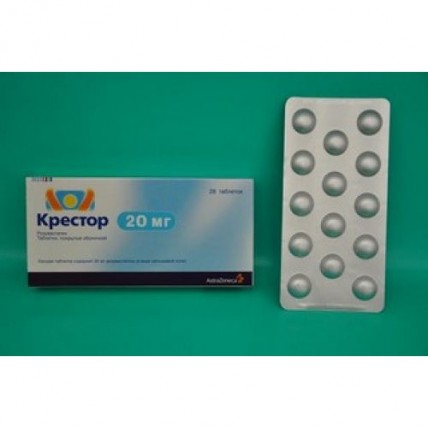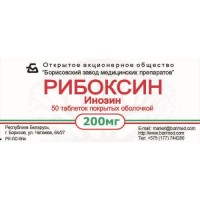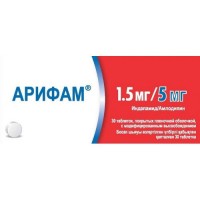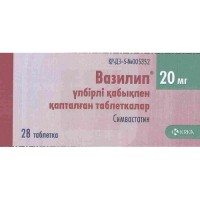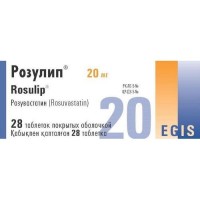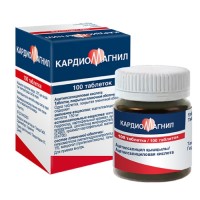Crestor 28's 20 mg coated tablets
- $71.70
The instruction for medical use
of KPECTOP medicine
the Trade name
Krestor
Mezhdunarodnoye the unlicensed
name Rosuvastatin Dosage Form
of the Tablet, coated 10 and 20 mg
Structure
One tablet contains
active agent: mg rosuvastatin 10 and 20 in the form of calcium rosuvastatin
excipients: lactoses monohydrate, cellulose microcrystalline, calcium phosphate, krospovidon, magnesium stearate, a gipromelloza, glycerin triacetate, the titan dioxide (E171), ferrous oxide red (E172), water cleaned.
Description
of the Tablet of 10 mg: tablets, coated, pink color, round, with a biconvex surface, with an engraving of ZD4522 10 on one party.
Tablets of 20 mg: tablets, coated, pink color, round, with a biconvex surface, with an engraving of ZD4522 20 on one party.
Pharmacotherapeutic group
Hypolipidemic drugs. Gipokholesterinemichesky and gipotriglitseridemichesky drugs. HMG-CoA reductases inhibitors. Rosuvastatin
the ATX C10A A07 Code
the Pharmacological
Pharmacokinetics Rosuvastatin properties is a selection, competitive inhibitor of HMG-CoA reductase - the enzyme turning 3-hydroxy-3-metilglutarilkoenzim A in mevalonat, the predecessor of cholesterol. The main target of effect of rosuvastatin is the liver where synthesis of cholesterol (XC) and catabolism of lipoproteins of the low density (LDL) is carried out.
Rosuvastatin increases number of hepatic receptors of LDL by surfaces of cells, increasing capture and catabolism of LDL that leads to inhibition of synthesis of lipoproteins of very low density (LPONP), reducing thereby total amount of LDL and LPONP. The maximum concentration of rosuvastatin in blood plasma is reached approximately in 5 hours after oral administration. The absolute bioavailability is about 20%. Rosuvastatin is absorbed, mainly, by a liver. The volume of distribution of rosuvastatin is about 134 l. About 90% of rosuvastatin contact proteins of plasma, generally albumine. Rosuvastatin is exposed to limited metabolism (about 10%). Rosuvastatin is non-core substrate for metabolism by enzymes of a system of P450 cytochrome. The main isoenzyme participating in rosuvastatin metabolism is CYP2C9. CYP2C19, CYP3A4 and CYP2D6 enzymes are involved in metabolism to a lesser extent.
The main revealed metabolites of rosuvastatin are N-dismetil and lactonic metabolites. N-dismetil for about 50% is less active, than rosuvastatin, lactonic metabolites are pharmacological not active. More than 90% of pharmacological activity on inhibition of the circulating HMG-CoA reductase are provided with rosuvastatin, the rest – its metabolites.
About 90% of a dose of rosuvastatin are removed in not changed view with excrements (including the absorbed and not absorbed rosuvastatin). The rest is removed with urine. Plasma elimination half-life (T ½) makes about 19 hours. Elimination half-life does not change at increase in a dose of drug. The average geometrical plasma clearance is about 50 liters/hour (coefficient of variation of 21.7%). As well as in case of other inhibitors of HMG-CoA reductase, the membrane carrier of cholesterol who is carrying out an important role in hepatic elimination of Krestor is involved in process of hepatic capture of rosuvastatin.
System exposure of rosuvastatin increases in proportion to a dose.
The therapeutic effect appears within one week after the beginning of therapy by Krestor, in 2 weeks of treatment reaches 90% of the greatest possible effect. The maximum therapeutic effect is usually reached by 4th week and maintained at regular reception.
The pharmacodynamics
Krestor reduces the increased content of cholesterol-LDL (HS-LPNP), the general cholesterol, triglycerides (TG), increases the content of cholesterol of lipoproteins of the high density (HS-LPVP) and also reduces apolipoprotein B content (ApoV), HS-neLPVP, HS-LPONP, TG-LPONP also increases the level of A-I apolipoprotein (ApoA-I), reduces a ratio of HS-LPNP/HS-LPVP, the general HS/HS-LPVP and HS-neLPVP/HS-LPVP and a ratio of ApoB/ApoA-I.
Krestor is effective at adult patients with a hypercholesterolemia with or without gipertriglitseridemiya, regardless of race, a floor or age, and with a family hypercholesterolemia.
Indications
- primary hypercholesterolemia (the IIa type, including a family heterozygous hypercholesterolemia) or the mixed dislipidemiya (IIb type) as addition to a diet when the diet and other non-drug methods of treatment (for example, physical exercises, decrease in body weight) are insufficient
- a family homozygous hypercholesterolemia as addition to a diet and other lipidsnizhayushchy therapy (for example, LPNP-aferez), or in cases when similar therapy is not suitable the patient
- as addition to a diet for delay of progressing of atherosclerosis at adult patients as a part of therapy for decrease in levels of the LPNP general cholesterol (OHS) and XC to target levels
- prevention of cardiovascular complications at adult patients with the increased risk of developing an atherosclerotic cardiovascular disease as auxiliary therapy.
A route of administration and doses
Inside not to chew and not to crush a tablet, to swallow entirely, washing down with water. It can be appointed irrespective of meal. Prior to the beginning of and during therapy by Krestor the patient has to keep to a standard hypolipidemic diet. The dose of drug has to be selected individually depending on the purposes of therapy and the response to treatment.
The recommended initial dose for the patients beginning to take the drug or for the patients transferred from intake of other inhibitors of HMG-CoA reductase has to make 5 or 10 mg of Krestor of 1 times a day. When choosing an initial dose it is necessary to be guided by the level of content of cholesterol and to take possible risk of cardiovascular complications into account and also it is necessary to estimate potential risk of development of side effects. In case of need, the dose can be increased after 4 weeks of administration of drug. To raise a dose of drug gradually.
Due to the possible development of side effects at reception of a dose of 40 mg, increase in a dose to the maximum 40 mg can be considered only at patients with a heavy hypercholesterolemia and with high risk of cardiovascular complications (especially at patients with a family hypercholesterolemia) at which the desirable result of therapy at reception of a dose of 20 mg was not achieved. Observation of the patients receiving drug in a dose of 40 mg is recommended.
Purpose of a dose of 40 mg is not recommended to the patients who were earlier not taking the drug. After 2-4 week therapies and/or at increase in a dose of Krestor the control of indicators of lipidic exchange is necessary (if necessary dose adjustment is required).
Prevention of cardiovascular complications at adult patients with the increased risk of developing an atherosclerotic cardiovascular disease as auxiliary therapy
the Recommended dose - 20 mg once a day.
Elderly patients
dose adjustment is not required. To patients 70 years are more senior the initial dose of drug of 5 mg is recommended.
Patients with a renal failure
with a renal failure easy or moderate severity dose adjustment is not required From patients, the recommended initial dose of drug of 5 mg. At patients with moderate renal failures (clearance of creatinine less than 60 ml/min.) - use of drug in a dosage of 40 mg is contraindicated. At patients with the profound renal failure (clearance of creatinine less than 30 ml/min.) - drug Krestor use is contraindicated.
Patients with a liver failure
Experience of use of drug for patients with point higher than 9 on a scale Chayld - I Drink is absent.
Special populations. Ethnic groups
When studying the pharmacokinetic Krestora parameters at the patients belonging to different ethnic groups the increase in system concentration of rosuvastatin at Japanese and Chinese is noted. It is necessary to consider this fact when prescribing rosuvastatin to these groups of patients. The recommended initial dose for patients of Asian race makes 5 mg.
The patients predisposed to a myopathy
prescribing of drug in a dose of 40 mg is contraindicated to patients with the factors predisposed to development of a myopathy. The recommended initial dose for this group of patients makes 5 mg.
The patients having genotypes of SLCO1B1 (OATP1B1) with. 521CC and ABCG2 with. 421AA are connected with increase in influence of rosuvastatin (SKM) in comparison with SLCO1B1 with. 521TT and ABCG2 with. 421CC. To patients with genotypes with. 521CC or with. 421AA it is recommended to accept Krestor® a maximum of times a day on 20 mg.
Side effects
Often (& gt, 1/100, & lt, 1/10)
- a headache, dizziness
- nausea, an abdominal pain, a constipation
- myalgias
- an asthenic syndrome
- diabetes of the II type
Infrequently (& gt, 1/1000, & lt, 1/100)
- an itching, rash, urticaria
Seldom (& gt, 1/10,000, & lt, 1/1,000)
- hypersensitivity reactions, including a Quincke's disease
- a myopathy, a rhabdomyolysis
- increase in level of hepatic transaminases, pancreatitis
Very seldom (& lt, 1/10,000)
- jaundice, hepatitis
- polyneuropathy
- memory loss
- a hamaturia
- arthralgias
- a depression, sleep disorders
- sexual dysfunction
Isolated cases
- interstitial diseases of lungs
of not specified frequency
- diarrhea
- the immunomediated necrotizing myopathy
- cough, short wind
- Stephens-Johnson's syndrome
- a gynecomastia
- peripheral swell
At the patients receiving Krestor the proteinuria can come to light. In most cases the proteinuria decreases or disappears in the course of therapy and does not mean emergence sharp or progressing of the existing disease of kidneys. As well as at use of other inhibitors of GMG-KoA-reduktazy, the frequency of emergence of side effects has dose-dependent character.
Contraindications
- hypersensitivity to rosuvastatin or any of drug components
- liver diseases in an active phase, including permanent increase in serumal activity of transaminases and any increase in activity of transaminases in blood serum (more than by 3 times in comparison with the upper bound of norm)
- the profound renal failures (less than 30 ml/min.)
- myopathies
- a concomitant use of cyclosporine
- pregnancy, the lactation period, lack of adequate methods
of contraception
- predisposition to development of miotoksichesky complications
- hereditary intolerance of a galactose,
a lactose intolerance or a sprue of glucose and a galactose
For a dose of 40 mg
- a renal failure of moderate severity (clearance of creatinine less than 60 ml/min.)
- a hypothyroidism
- states which can lead to increase in plasma concentration of rosuvastatin
- a concomitant use of fibrat
- patients of Asian race
- muscular diseases in the anamnesis
- a miotoksichnost against the background of intake of other GMG-KoA inhibitors – reductase or fibrat in the anamnesis
- an alcohol abuse
Medicinal interactions
Cyclosporine
Combined use leads clearance of creatinine to increase in concentration of Krestor in blood plasma by 7 times. Does not affect plasma concentration of cyclosporine.
Antagonists of vitamin K
the Beginning of therapy by Krestor or increase in a dose of drug at the patients receiving at the same time antagonists of vitamin K (for example, warfarin), can lead to increase in a prothrombin time. Cancellation of rosuvastatin or a dose decline of drug can lead to reduction of MNO. In such cases the monitoring of MNO is recommended.
Fenofibraty / derivatives of fibroyevy
Gemfibrozil acid, fenofibrat and other fibroyevy acids, including niacin, can increase risk of emergence of a myopathy at introduction along with rosuvastatin.
Inhibitors of proteases
In spite of the fact that the dot mechanism of interaction is not known, joint intake of inhibitors of proteases can lead to significant increase in exposure of rosuvastatin. The pharmacokinetic research on simultaneous use of 20 mg of rosuvastatin with the combined drug containing two inhibitors of proteases (400 mg lopinavira/100 mg of a ritonavir) at healthy volunteers led to approximately double or fivefold increase in AUC (0-24) (to the area under a curve concentration time) and (Cmax) (the maximum concentration in blood plasma) rosuvastatin respectively. Therefore the concomitant use of rosuvastatin and inhibitors of proteases at treatment of patients with HIV is not recommended.
Simultaneous use of Krestor and suspensions of the antacids containing aluminum and magnesium hydroxide leads antacids to decrease in plasma concentration of rosuvastatin approximately for 50%. This effect is significant more weakly if antacids are applied in 2 hours after intake of rosuvastatin.
Erythromycin
leads Simultaneous use of Krestor and erythromycin to reduction of AUC (0 – t) rosuvastatin for 20% and Cmax of rosuvastatin for 30%. Similar interaction can result from strengthening of motility of the intestines caused by intake of erythromycin.
Oral contraceptives / gormonozamestitelny therapy
increases Simultaneous use of rosuvastatin and oral contraceptives AUC ethinylestradiol and AUC Norgestrelum by 26% and 34%, respectively. Such increase in plasma concentration has to be considered at selection of a dose of oral contraceptives. However the similar combination was widely used during conduct of clinical trials and well transferred by patients.
Digoxin
is not expected clinically significant interaction of rosuvastatin with digoxin.
P450 cytochrome enzymes
Rosuvastatin is not either inhibitor, or the inductor of enzymes of P450 cytochrome. Besides, rosuvastatin is weak substrate for these enzymes. Clinically significant interaction between rosuvastatin, flukonazoly (CYP2C9 and CYP3A4 inhibitor) and ketokonazoly was not noted (CYP2A6 CYP3A4 inhibitor). Combined use of Krestor and an itrakonazol (CYP3A4 inhibitor) increases AUC rosuvastatin by 28%. Thus, the interaction connected with P450 cytochrome metabolism is not expected.
Special instructions
With care
For doses less than 40 mg: the personal or family anamnesis of hereditary muscular diseases and the previous anamnesis of muscular toxicity when using other inhibitors of GMG-KoA-reduktazy or fibrat, excessive alcohol intake, a hypothyroidism, race (Asian race), co-administration from fibrata.
Presence of risk of developing a myopathy/rhabdomyolysis - a renal failure, age is more senior than 70 years, states at which increase in plasma concentration of rosuvastatin, liver diseases in the anamnesis, sepsis, arterial hypotension, extensive surgical interventions, injuries, heavy metabolic, endocrine or electrolytic disturbances or uncontrollable epilepsy is noted.
Use in pediatric practice
the Efficiency and safety of use of drug for children up to 18 years is not established. If necessary Krestor in other dosage (5 mg) is applied.
From the musculoskeletal system
At Krestor's use in all dosages and, in particular at reception of the doses of drug exceeding 20 mg it was reported about the following impacts on the musculoskeletal system: myalgia, myopathy, in rare instances rhabdomyolysis.
Definition of a kreatinfosfokinaza
of KFK should not be carried out after intensive physical activities or in the presence of other possible reasons of increase in KFK, can lead to incorrect interpretation of the received results. In case the KFK initial level is significantly increased (5 times higher, than the upper bound of norm), in 5 - 7 days it is necessary to take repeated measurement. It is not necessary to begin therapy if the repeated test confirms the KFK initial level (more than 5 times higher in comparison with the upper bound of norm).
It is necessary to inform the patient on need of the immediate message to the doctor about cases of unexpected appearance of muscular pains, muscle weakness or spasms, especially in combination with an indisposition and fever. At such patients it is necessary to determine the KFK level. Therapy has to be stopped if the KFK level is considerably increased (more than by 5 times in comparison with the upper bound of norm) or if symptoms from muscles are pronounced and cause daily discomfort (even if the KFK level is 5 times less in comparison with the upper bound of norm). If symptoms disappear and the KFK level returns to norm, it is necessary to consider a question of repeated appointment of Krestor or other inhibitors of GMG-KoA-reduktazy in smaller doses at careful observation of the patient. Routine control of KFK in the absence of symptoms is not reasonable.
Very exceptional cases of the immunomediated necrotizing myopathy with clinical manifestations in the form of resistant weakness of proximal muscles and increase in the KFK level in blood serum are celebrated during treatment or the termination of intake of statines, including rosuvastatin. Carrying out additional researches of muscular and nervous systems, serological researches and also therapy by immunosuppressive means can be required.
Signs of increase in impact on skeletal muscles at Krestor's reception and the accompanying therapy are noted. It was reported about increase in number of cases of a miositis and a myopathy at the patients accepting other inhibitors of GMG-KoA-reduktazy in combination with derivatives of fibrinous acid, including gemfibrozit, cyclosporine, niacin, azolny antifungal means, inhibitors of proteases and makrolidny antibiotics. Gemfibrozil increases risk of emergence of a myopathy at the combined appointment with some inhibitors of GMG-KoA-reduktazy. Thus, co-administration of Krestor and a gemfibrozil is not recommended. The ratio of risk and possible advantage at combined use of Krestor and fibrat or Niacinum has to be carefully weighed.
In 2-4 weeks after an initiation of treatment and/or at increase in a dose of Krestor the control of indicators of lipidic exchange is necessary (if necessary dose adjustment is required).
The liver
Is recommended to carry out definition of indicators of function of a liver prior to therapy and in 3 months after the beginning of therapy. Krestor's reception it is necessary to stop or reduce a drug dose if the level of activity of transaminases in blood sera by 3 times exceeds the upper bound of norm. At patients with a hypercholesterolemia owing to a hypothyroidism or a nephrotic syndrome therapy of basic diseases has to be carried out prior to treatment by Krestor.
The interstitial disease of lungs
At use of statines was reported about single cases of an interstitial disease of lungs, especially, when long therapy was carried out. The described signs can include short wind, dry cough and the general aggravation of symptoms (fatigue, loss of weight and fever). If there are suspicions on development in the patient of an interstitial disease of lungs, therapy by statines it is necessary to stop.
Diabetes of the II type
At patients with glucose level in blood on an empty stomach of 5.6 - 6.9 mmol/l, treatment by rosuvastatin contacted the diabetes raised by risk of a disease.
Ethnic groups
during the pharmacokinetic researches among the Chinese and Japanese patients the increase in system concentration of rosuvastatin in comparison with the indicators received among patients - Europeans is noted.
Influence on ability to driving of motor transport and to control of mechanisms
During the driving or work with mechanisms needs to be considered that during therapy there can be dizziness.
Overdose
Symptoms - expressiveness of symptoms of side effects.
Treatment - symptomatic and the supporting actions. Control of function of a liver and the KFK level is necessary. It is improbable that the hemodialysis will be effective.
A release form
On 14 tablets place in blister strip packaging from a firm film polyvinylchloride silvery color and the printing aluminum foil varnished.
On 2 blister strip packagings on 14 tablets (dosage of 10 mg) together with the instruction for medical use in the state and Russian languages place in a pack from cardboard with control of the first opening. Control of the first opening can be present not at all packings.
On 2 blister strip packagings on 14 tablets (dosage of 20 mg) together with the instruction for medical use in the state and Russian languages place in a pack from cardboard with control of the first opening. Control of the first opening can be present not at all packings.
To Store storage conditions at a temperature not above 30 °C.
To store in places inaccessible for children.
Period of storage
3 years.
Not to apply on expiry date.
Prescription status
According to the prescription
the Producer
IPR of Pharmasyyutikals of INK., Puerto Rico
the Name and the country
of the AstraZeneka YuK Limited organization packer, Great Britain
the Owner of the registration certificate
of AstraZeneka YuK Limited, Great Britain
the Address of the organization accepting claims from consumers on quality of products (goods) in the territory of the Republic of Kazakhstan
Representative office of ZAK AstraZeneka YuK Limited in the Republic of Kazakhstan
Phone number: +7 727 226 25 30, fax: +7 727 226 25 29
e-mail Is made: Aigul.Doszhanova@astrazeneca.com
Krestor a trademark - the property
of the AstraZeneka Razvernut company
of KPECTOP medicine
the Trade name
Krestor
Mezhdunarodnoye the unlicensed
name Rosuvastatin Dosage Form
of the Tablet, coated 10 and 20 mg
Structure
One tablet contains
active agent: mg rosuvastatin 10 and 20 in the form of calcium rosuvastatin
excipients: lactoses monohydrate, cellulose microcrystalline, calcium phosphate, krospovidon, magnesium stearate, a gipromelloza, glycerin triacetate, the titan dioxide (E171), ferrous oxide red (E172), water cleaned.
Description
of the Tablet of 10 mg: tablets, coated, pink color, round, with a biconvex surface, with an engraving of ZD4522 10 on one party.
Tablets of 20 mg: tablets, coated, pink color, round, with a biconvex surface, with an engraving of ZD4522 20 on one party.
Pharmacotherapeutic group
Hypolipidemic drugs. Gipokholesterinemichesky and gipotriglitseridemichesky drugs. HMG-CoA reductases inhibitors. Rosuvastatin
the ATX C10A A07 Code
the Pharmacological
Pharmacokinetics Rosuvastatin properties is a selection, competitive inhibitor of HMG-CoA reductase - the enzyme turning 3-hydroxy-3-metilglutarilkoenzim A in mevalonat, the predecessor of cholesterol. The main target of effect of rosuvastatin is the liver where synthesis of cholesterol (XC) and catabolism of lipoproteins of the low density (LDL) is carried out.
Rosuvastatin increases number of hepatic receptors of LDL by surfaces of cells, increasing capture and catabolism of LDL that leads to inhibition of synthesis of lipoproteins of very low density (LPONP), reducing thereby total amount of LDL and LPONP. The maximum concentration of rosuvastatin in blood plasma is reached approximately in 5 hours after oral administration. The absolute bioavailability is about 20%. Rosuvastatin is absorbed, mainly, by a liver. The volume of distribution of rosuvastatin is about 134 l. About 90% of rosuvastatin contact proteins of plasma, generally albumine. Rosuvastatin is exposed to limited metabolism (about 10%). Rosuvastatin is non-core substrate for metabolism by enzymes of a system of P450 cytochrome. The main isoenzyme participating in rosuvastatin metabolism is CYP2C9. CYP2C19, CYP3A4 and CYP2D6 enzymes are involved in metabolism to a lesser extent.
The main revealed metabolites of rosuvastatin are N-dismetil and lactonic metabolites. N-dismetil for about 50% is less active, than rosuvastatin, lactonic metabolites are pharmacological not active. More than 90% of pharmacological activity on inhibition of the circulating HMG-CoA reductase are provided with rosuvastatin, the rest – its metabolites.
About 90% of a dose of rosuvastatin are removed in not changed view with excrements (including the absorbed and not absorbed rosuvastatin). The rest is removed with urine. Plasma elimination half-life (T ½) makes about 19 hours. Elimination half-life does not change at increase in a dose of drug. The average geometrical plasma clearance is about 50 liters/hour (coefficient of variation of 21.7%). As well as in case of other inhibitors of HMG-CoA reductase, the membrane carrier of cholesterol who is carrying out an important role in hepatic elimination of Krestor is involved in process of hepatic capture of rosuvastatin.
System exposure of rosuvastatin increases in proportion to a dose.
The therapeutic effect appears within one week after the beginning of therapy by Krestor, in 2 weeks of treatment reaches 90% of the greatest possible effect. The maximum therapeutic effect is usually reached by 4th week and maintained at regular reception.
The pharmacodynamics
Krestor reduces the increased content of cholesterol-LDL (HS-LPNP), the general cholesterol, triglycerides (TG), increases the content of cholesterol of lipoproteins of the high density (HS-LPVP) and also reduces apolipoprotein B content (ApoV), HS-neLPVP, HS-LPONP, TG-LPONP also increases the level of A-I apolipoprotein (ApoA-I), reduces a ratio of HS-LPNP/HS-LPVP, the general HS/HS-LPVP and HS-neLPVP/HS-LPVP and a ratio of ApoB/ApoA-I.
Krestor is effective at adult patients with a hypercholesterolemia with or without gipertriglitseridemiya, regardless of race, a floor or age, and with a family hypercholesterolemia.
Indications
- primary hypercholesterolemia (the IIa type, including a family heterozygous hypercholesterolemia) or the mixed dislipidemiya (IIb type) as addition to a diet when the diet and other non-drug methods of treatment (for example, physical exercises, decrease in body weight) are insufficient
- a family homozygous hypercholesterolemia as addition to a diet and other lipidsnizhayushchy therapy (for example, LPNP-aferez), or in cases when similar therapy is not suitable the patient
- as addition to a diet for delay of progressing of atherosclerosis at adult patients as a part of therapy for decrease in levels of the LPNP general cholesterol (OHS) and XC to target levels
- prevention of cardiovascular complications at adult patients with the increased risk of developing an atherosclerotic cardiovascular disease as auxiliary therapy.
A route of administration and doses
Inside not to chew and not to crush a tablet, to swallow entirely, washing down with water. It can be appointed irrespective of meal. Prior to the beginning of and during therapy by Krestor the patient has to keep to a standard hypolipidemic diet. The dose of drug has to be selected individually depending on the purposes of therapy and the response to treatment.
The recommended initial dose for the patients beginning to take the drug or for the patients transferred from intake of other inhibitors of HMG-CoA reductase has to make 5 or 10 mg of Krestor of 1 times a day. When choosing an initial dose it is necessary to be guided by the level of content of cholesterol and to take possible risk of cardiovascular complications into account and also it is necessary to estimate potential risk of development of side effects. In case of need, the dose can be increased after 4 weeks of administration of drug. To raise a dose of drug gradually.
Due to the possible development of side effects at reception of a dose of 40 mg, increase in a dose to the maximum 40 mg can be considered only at patients with a heavy hypercholesterolemia and with high risk of cardiovascular complications (especially at patients with a family hypercholesterolemia) at which the desirable result of therapy at reception of a dose of 20 mg was not achieved. Observation of the patients receiving drug in a dose of 40 mg is recommended.
Purpose of a dose of 40 mg is not recommended to the patients who were earlier not taking the drug. After 2-4 week therapies and/or at increase in a dose of Krestor the control of indicators of lipidic exchange is necessary (if necessary dose adjustment is required).
Prevention of cardiovascular complications at adult patients with the increased risk of developing an atherosclerotic cardiovascular disease as auxiliary therapy
the Recommended dose - 20 mg once a day.
Elderly patients
dose adjustment is not required. To patients 70 years are more senior the initial dose of drug of 5 mg is recommended.
Patients with a renal failure
with a renal failure easy or moderate severity dose adjustment is not required From patients, the recommended initial dose of drug of 5 mg. At patients with moderate renal failures (clearance of creatinine less than 60 ml/min.) - use of drug in a dosage of 40 mg is contraindicated. At patients with the profound renal failure (clearance of creatinine less than 30 ml/min.) - drug Krestor use is contraindicated.
Patients with a liver failure
Experience of use of drug for patients with point higher than 9 on a scale Chayld - I Drink is absent.
Special populations. Ethnic groups
When studying the pharmacokinetic Krestora parameters at the patients belonging to different ethnic groups the increase in system concentration of rosuvastatin at Japanese and Chinese is noted. It is necessary to consider this fact when prescribing rosuvastatin to these groups of patients. The recommended initial dose for patients of Asian race makes 5 mg.
The patients predisposed to a myopathy
prescribing of drug in a dose of 40 mg is contraindicated to patients with the factors predisposed to development of a myopathy. The recommended initial dose for this group of patients makes 5 mg.
The patients having genotypes of SLCO1B1 (OATP1B1) with. 521CC and ABCG2 with. 421AA are connected with increase in influence of rosuvastatin (SKM) in comparison with SLCO1B1 with. 521TT and ABCG2 with. 421CC. To patients with genotypes with. 521CC or with. 421AA it is recommended to accept Krestor® a maximum of times a day on 20 mg.
Side effects
Often (& gt, 1/100, & lt, 1/10)
- a headache, dizziness
- nausea, an abdominal pain, a constipation
- myalgias
- an asthenic syndrome
- diabetes of the II type
Infrequently (& gt, 1/1000, & lt, 1/100)
- an itching, rash, urticaria
Seldom (& gt, 1/10,000, & lt, 1/1,000)
- hypersensitivity reactions, including a Quincke's disease
- a myopathy, a rhabdomyolysis
- increase in level of hepatic transaminases, pancreatitis
Very seldom (& lt, 1/10,000)
- jaundice, hepatitis
- polyneuropathy
- memory loss
- a hamaturia
- arthralgias
- a depression, sleep disorders
- sexual dysfunction
Isolated cases
- interstitial diseases of lungs
of not specified frequency
- diarrhea
- the immunomediated necrotizing myopathy
- cough, short wind
- Stephens-Johnson's syndrome
- a gynecomastia
- peripheral swell
At the patients receiving Krestor the proteinuria can come to light. In most cases the proteinuria decreases or disappears in the course of therapy and does not mean emergence sharp or progressing of the existing disease of kidneys. As well as at use of other inhibitors of GMG-KoA-reduktazy, the frequency of emergence of side effects has dose-dependent character.
Contraindications
- hypersensitivity to rosuvastatin or any of drug components
- liver diseases in an active phase, including permanent increase in serumal activity of transaminases and any increase in activity of transaminases in blood serum (more than by 3 times in comparison with the upper bound of norm)
- the profound renal failures (less than 30 ml/min.)
- myopathies
- a concomitant use of cyclosporine
- pregnancy, the lactation period, lack of adequate methods
of contraception
- predisposition to development of miotoksichesky complications
- hereditary intolerance of a galactose,
a lactose intolerance or a sprue of glucose and a galactose
For a dose of 40 mg
- a renal failure of moderate severity (clearance of creatinine less than 60 ml/min.)
- a hypothyroidism
- states which can lead to increase in plasma concentration of rosuvastatin
- a concomitant use of fibrat
- patients of Asian race
- muscular diseases in the anamnesis
- a miotoksichnost against the background of intake of other GMG-KoA inhibitors – reductase or fibrat in the anamnesis
- an alcohol abuse
Medicinal interactions
Cyclosporine
Combined use leads clearance of creatinine to increase in concentration of Krestor in blood plasma by 7 times. Does not affect plasma concentration of cyclosporine.
Antagonists of vitamin K
the Beginning of therapy by Krestor or increase in a dose of drug at the patients receiving at the same time antagonists of vitamin K (for example, warfarin), can lead to increase in a prothrombin time. Cancellation of rosuvastatin or a dose decline of drug can lead to reduction of MNO. In such cases the monitoring of MNO is recommended.
Fenofibraty / derivatives of fibroyevy
Gemfibrozil acid, fenofibrat and other fibroyevy acids, including niacin, can increase risk of emergence of a myopathy at introduction along with rosuvastatin.
Inhibitors of proteases
In spite of the fact that the dot mechanism of interaction is not known, joint intake of inhibitors of proteases can lead to significant increase in exposure of rosuvastatin. The pharmacokinetic research on simultaneous use of 20 mg of rosuvastatin with the combined drug containing two inhibitors of proteases (400 mg lopinavira/100 mg of a ritonavir) at healthy volunteers led to approximately double or fivefold increase in AUC (0-24) (to the area under a curve concentration time) and (Cmax) (the maximum concentration in blood plasma) rosuvastatin respectively. Therefore the concomitant use of rosuvastatin and inhibitors of proteases at treatment of patients with HIV is not recommended.
Simultaneous use of Krestor and suspensions of the antacids containing aluminum and magnesium hydroxide leads antacids to decrease in plasma concentration of rosuvastatin approximately for 50%. This effect is significant more weakly if antacids are applied in 2 hours after intake of rosuvastatin.
Erythromycin
leads Simultaneous use of Krestor and erythromycin to reduction of AUC (0 – t) rosuvastatin for 20% and Cmax of rosuvastatin for 30%. Similar interaction can result from strengthening of motility of the intestines caused by intake of erythromycin.
Oral contraceptives / gormonozamestitelny therapy
increases Simultaneous use of rosuvastatin and oral contraceptives AUC ethinylestradiol and AUC Norgestrelum by 26% and 34%, respectively. Such increase in plasma concentration has to be considered at selection of a dose of oral contraceptives. However the similar combination was widely used during conduct of clinical trials and well transferred by patients.
Digoxin
is not expected clinically significant interaction of rosuvastatin with digoxin.
P450 cytochrome enzymes
Rosuvastatin is not either inhibitor, or the inductor of enzymes of P450 cytochrome. Besides, rosuvastatin is weak substrate for these enzymes. Clinically significant interaction between rosuvastatin, flukonazoly (CYP2C9 and CYP3A4 inhibitor) and ketokonazoly was not noted (CYP2A6 CYP3A4 inhibitor). Combined use of Krestor and an itrakonazol (CYP3A4 inhibitor) increases AUC rosuvastatin by 28%. Thus, the interaction connected with P450 cytochrome metabolism is not expected.
Special instructions
With care
For doses less than 40 mg: the personal or family anamnesis of hereditary muscular diseases and the previous anamnesis of muscular toxicity when using other inhibitors of GMG-KoA-reduktazy or fibrat, excessive alcohol intake, a hypothyroidism, race (Asian race), co-administration from fibrata.
Presence of risk of developing a myopathy/rhabdomyolysis - a renal failure, age is more senior than 70 years, states at which increase in plasma concentration of rosuvastatin, liver diseases in the anamnesis, sepsis, arterial hypotension, extensive surgical interventions, injuries, heavy metabolic, endocrine or electrolytic disturbances or uncontrollable epilepsy is noted.
Use in pediatric practice
the Efficiency and safety of use of drug for children up to 18 years is not established. If necessary Krestor in other dosage (5 mg) is applied.
From the musculoskeletal system
At Krestor's use in all dosages and, in particular at reception of the doses of drug exceeding 20 mg it was reported about the following impacts on the musculoskeletal system: myalgia, myopathy, in rare instances rhabdomyolysis.
Definition of a kreatinfosfokinaza
of KFK should not be carried out after intensive physical activities or in the presence of other possible reasons of increase in KFK, can lead to incorrect interpretation of the received results. In case the KFK initial level is significantly increased (5 times higher, than the upper bound of norm), in 5 - 7 days it is necessary to take repeated measurement. It is not necessary to begin therapy if the repeated test confirms the KFK initial level (more than 5 times higher in comparison with the upper bound of norm).
It is necessary to inform the patient on need of the immediate message to the doctor about cases of unexpected appearance of muscular pains, muscle weakness or spasms, especially in combination with an indisposition and fever. At such patients it is necessary to determine the KFK level. Therapy has to be stopped if the KFK level is considerably increased (more than by 5 times in comparison with the upper bound of norm) or if symptoms from muscles are pronounced and cause daily discomfort (even if the KFK level is 5 times less in comparison with the upper bound of norm). If symptoms disappear and the KFK level returns to norm, it is necessary to consider a question of repeated appointment of Krestor or other inhibitors of GMG-KoA-reduktazy in smaller doses at careful observation of the patient. Routine control of KFK in the absence of symptoms is not reasonable.
Very exceptional cases of the immunomediated necrotizing myopathy with clinical manifestations in the form of resistant weakness of proximal muscles and increase in the KFK level in blood serum are celebrated during treatment or the termination of intake of statines, including rosuvastatin. Carrying out additional researches of muscular and nervous systems, serological researches and also therapy by immunosuppressive means can be required.
Signs of increase in impact on skeletal muscles at Krestor's reception and the accompanying therapy are noted. It was reported about increase in number of cases of a miositis and a myopathy at the patients accepting other inhibitors of GMG-KoA-reduktazy in combination with derivatives of fibrinous acid, including gemfibrozit, cyclosporine, niacin, azolny antifungal means, inhibitors of proteases and makrolidny antibiotics. Gemfibrozil increases risk of emergence of a myopathy at the combined appointment with some inhibitors of GMG-KoA-reduktazy. Thus, co-administration of Krestor and a gemfibrozil is not recommended. The ratio of risk and possible advantage at combined use of Krestor and fibrat or Niacinum has to be carefully weighed.
In 2-4 weeks after an initiation of treatment and/or at increase in a dose of Krestor the control of indicators of lipidic exchange is necessary (if necessary dose adjustment is required).
The liver
Is recommended to carry out definition of indicators of function of a liver prior to therapy and in 3 months after the beginning of therapy. Krestor's reception it is necessary to stop or reduce a drug dose if the level of activity of transaminases in blood sera by 3 times exceeds the upper bound of norm. At patients with a hypercholesterolemia owing to a hypothyroidism or a nephrotic syndrome therapy of basic diseases has to be carried out prior to treatment by Krestor.
The interstitial disease of lungs
At use of statines was reported about single cases of an interstitial disease of lungs, especially, when long therapy was carried out. The described signs can include short wind, dry cough and the general aggravation of symptoms (fatigue, loss of weight and fever). If there are suspicions on development in the patient of an interstitial disease of lungs, therapy by statines it is necessary to stop.
Diabetes of the II type
At patients with glucose level in blood on an empty stomach of 5.6 - 6.9 mmol/l, treatment by rosuvastatin contacted the diabetes raised by risk of a disease.
Ethnic groups
during the pharmacokinetic researches among the Chinese and Japanese patients the increase in system concentration of rosuvastatin in comparison with the indicators received among patients - Europeans is noted.
Influence on ability to driving of motor transport and to control of mechanisms
During the driving or work with mechanisms needs to be considered that during therapy there can be dizziness.
Overdose
Symptoms - expressiveness of symptoms of side effects.
Treatment - symptomatic and the supporting actions. Control of function of a liver and the KFK level is necessary. It is improbable that the hemodialysis will be effective.
A release form
On 14 tablets place in blister strip packaging from a firm film polyvinylchloride silvery color and the printing aluminum foil varnished.
On 2 blister strip packagings on 14 tablets (dosage of 10 mg) together with the instruction for medical use in the state and Russian languages place in a pack from cardboard with control of the first opening. Control of the first opening can be present not at all packings.
On 2 blister strip packagings on 14 tablets (dosage of 20 mg) together with the instruction for medical use in the state and Russian languages place in a pack from cardboard with control of the first opening. Control of the first opening can be present not at all packings.
To Store storage conditions at a temperature not above 30 °C.
To store in places inaccessible for children.
Period of storage
3 years.
Not to apply on expiry date.
Prescription status
According to the prescription
the Producer
IPR of Pharmasyyutikals of INK., Puerto Rico
the Name and the country
of the AstraZeneka YuK Limited organization packer, Great Britain
the Owner of the registration certificate
of AstraZeneka YuK Limited, Great Britain
the Address of the organization accepting claims from consumers on quality of products (goods) in the territory of the Republic of Kazakhstan
Representative office of ZAK AstraZeneka YuK Limited in the Republic of Kazakhstan
Phone number: +7 727 226 25 30, fax: +7 727 226 25 29
e-mail Is made: Aigul.Doszhanova@astrazeneca.com
Krestor a trademark - the property
of the AstraZeneka Razvernut company
